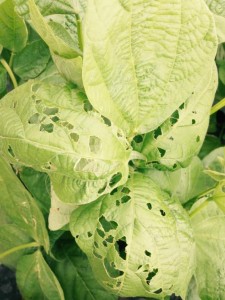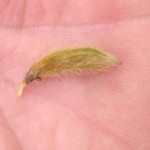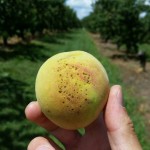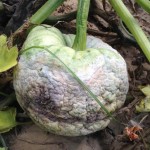FINAL SCOUTING REPORT FOR 2015
General Comments: It is very dry, no rain again this past week. Scouts are noting signs of moisture stress across fruit, vegetable and agronomic crops.
Fruit:
Some early apple varieties are being harvested. This past week codling moth trap numbers have declined slightly but growers could still see damage from codling moth larvae on later maturing apple varieties. Other insect pests noted on scouting reports this last week of scouting include green apple aphids and European red mites. As apple varieties near harvest, growers need to be vigilant about reading labels and watching pre-harvest intervals if they need to treat for codling moths or any other insect pest. Disease-wise, most growers have done an excellent job of keeping up and maintaining fungicide spray programs and scouts are noting very little disease. There have been a few apples with some fly speck and some apples with white rot symptoms. (See picture below of harvesting apples)
Oriental fruit moth trap captures remained high again this past week in pheromone traps. Growers need to be on a regular spray advisory to prevent damage from OFM larvae, but need to watch labels for pre-harvest intervals as many peaches are currently being harvested. Once again this past week we had spotted wing drosophila (SWD) captures from traps in peaches. One trap had more than 20 SWD.
In small fruit, spotted wing drosophila (SWD) trap capture numbers have been increasing in control traps placed near wild fruit that is not being treated with insecticides. These traps have captured more than 400 SWD this past week. Some raspberry and grape traps also contained some very high numbers of SWD this past week. Growers need to remain diligent in maintaining a consistent spray program and in making sure that coverage is from the top to the
bottom of the plants and penetrating into the canopy of the plants.
Vegetables:
Lack of rainfall is causing a lot of moisture stress, especially in larger fields without irrigation or in any smaller plantings without irrigation.
Tomatoes are being harvested. Scouts continue to see septoria leaf spot, and early blight in both field and high tunnel production. Due to the dry weather, blossom end rot is being seen more frequently by scouts in field grown tomatoes. In high tunnel production leaf mold continues on some farms and late blight is showing up in a few high tunnels as well along with powdery mildew. Scouts continued to find tomatoes with stink bug stings in both field and high tunnel production tomatoes. Aphids are being seen in some high tunnels as well. This past week 2-spotted spider mites at treatment threshold levels were found in some high tunnel tomatoes.
Cole crops planted for fall harvest continue to have pressure from imported cabbage worm with many plantings above treatment threshold levels. Zebra caterpillars were found in several fields this past week.
Depending upon the planting date, vine crops range from bloom to harvest. This past week scouts noted wilting leaves and dying leaves in pumpkin and squash fields that are not irrigated. The combination of moisture stress and earlier disease damage, particularly from anthracnose is responsible for this collapse. There are a lot of cucumbers, summer squash, zucchini, and melons (cantaloupe and watermelon) currently being harvested. Powdery mildew is being found by scouts in virtually every planting and growers are being advised on maintaining a fungicide spray program to minimize damage from this disease.
Downy mildew has been found in a number of cucumber plantings and some growers have been able to greatly slow or even arrest the development of the disease with a good fungicide spray program and some help from recent dry and hot weather conditions. Downy mildew has also been found in some plantings of cantaloupe and that disease is now beginning to show up in some squash plantings as well. Anthracnose and angular leaf spot are also commonly noted by scouts in many melon and fall squash and pumpkin plantings. Plectosporium blight has been found in several pumpkin plantings as well and symptoms of the disease are showing up on some of the ripening pumpkin fruit. Other diseases that have been noted, but that are not widespread, include phytophthora fruit rot, fusarium fruit rot and septoria leaf and fruit spot. Insect-wise, cucumber beetles continue to be present at anywhere from light to threshold or above numbers and some damage by cucumber beetles chewing on the rinds and stem handles of squash were noted by scouts. Some fields had localized heavy infestation of squash bugs.
Eggplant and pepper fruit are being harvested. Scouts noted moisture stress on plants in a number of fields. Sunscald is being noted on both crops by scouts on a frequent basis. Many of those sun scalded fruit are developing secondary botrytis infections. Anthracnose has been found on both leaves and fruit. Alternaria was also noted by scouts in both peppers and eggplant this past week. Some fusarium wilt on eggplant was noted again this week along with some bacterial soft rot in peppers. In some eggplant plantings Colorado potato beetle numbers were at treatment threshold levels. In peppers, some growers are treating for European corn borer (ECB) larvae to prevent damage, and ECB moth numbers in pheromone traps averaged 16/week, so growers do need to be treating to prevent damage. Stink bug stings have been noted on fruit by scouts along withthe presence of aphids.Green snap beans range from in bloom to harvest. Scouts have not noted any disease problems in green beans. Insects that are present include bean leaf beetle, grasshoppers, Japanese beetles and aphids.

Photo Courtesy Christine Smedley

Photo Courtesy Christine Smedley
Sweet corn ranges from plants at V-8 to harvest. Corn earworm trap numbers started to increase this past week. Trap captures ranged from 0 to 8. This may be an indication that the population is starting to increase and growers will need to protect corn at green silk with a shorter interval spray program. European corn borer moth captures ranged from 0 to 2 at 3 locations. Scouts noted some damage to ears from European corn borer larvae and some light flea beetle damage was noted in some plantings by scouts this past week. Northern corn leaf blight was noted on the lower leaves of some plantings. Much of the sweet corn, if not irrigated, is showing drought stress. Bird and raccoon damage was noted in some plantings by scouts.
Potato harvest is underway in many plantings or plants are drying down so insect and disease monitoring has ended on this crop.
Agronomic Field Crops:
Scouting has ended on a lot of field corn as corn enters the R3-R4 stage of development. In some later plantings corn rootworm beetles have been noted.
Soybeans range from R-5 to R-7. Scouts are noting that soybeans are under moisture stress and some pods are being aborted. (See picture below of pod) Stink bug numbers are low and grasshopper numbers have declined as well. This week, scouts are noting light to moderate aphid numbers but scouts are also finding ladybird beetles which are a predator of aphids. At this point the ladybird beetles are holding aphid populations in check. This week 2-spotted spider mites were found in low numbers on a couple of fields, probably a reflection of the dry weather being experienced.
Alfalfa regrowth following 3rd cut harvest is slow, due to the current dry conditions. Fortunately potato leaf hopper numbers remain very low and are not causing additional stress to alfalfa plants. However, aphid numbers are increasing and were approaching or right at threshold levels in a couple of fields. Growers will need to continue to monitor and see if ladybird beetle populations develop that can control the aphid population.


















